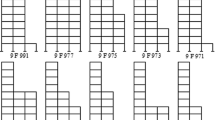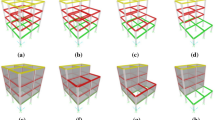Abstract
The fishbone model is a simplified numerical model for moment-resisting frames that is capable of modelling the effects of column-beam strength and stiffness ratios. The applicability of the fishbone model in simulating the seismic responses of reinforced concrete moment-resisting frames of different sets of column-beam strength and stiffness ratios are evaluated through nonlinear static, dynamic and incremental dynamic analysis on six prototype buildings of 4-, 8- and 12-stories. The results show that the fishbone model is practically accurate enough for reinforced concrete frames, although the assumption of equal joint rotation does not hold in all cases. In addition to the ground motion characteristics and the number of stories in the structures, the accuracy of the model also varies with the column-beam stiffness and strength ratios. The model performs better for strong column-weak beam frames, in which the lateral drift patterns are better controlled by the continuous stiffness provided by the strong columns. When the inelastic deformation is large, the accuracy of the model may be subjected to large record-to-record variability. This is especially the case for frames of weak columns.
Similar content being viewed by others
References
Ancheta TD, Darragh RB, Stewart JP, Silva WJ, Chiou BSJ, Wooddell KE, Graves RW, Kottke AR, Boore DM, Kishida T and Donahue JL (2013), PEER NGA-West2 Database, Pacific Earthquake Engineering Research Center, Report 2013/03, [http://ngawest2.berkeley.edu/].
ASCE (2010), Minimum Design Loads for Buildings and Other Structures, ASCE/SEI 7–10, American Society of Civil Engineers, Reston, Virginia.
EN1998-1 (2004), Eurocode 8: Design of Structures for Earthquake Resistance–Part 1: General Rules, Seismic Actions and Rules for Buildings, European Committee for Standardization.
FEMA (2009), Quantification of Building Seismic Performance Factors, FEMA P695, Federal Emergency Management Agency, Washington, D.C.
FEMA (2012), Seismic Performance Assessment of Buildings, FEMA P58. Federal Emergency Management Agency, Washington, D.C., 2012.
Guo ZH (1999), Theories of Reinforced Concrete, Beijing: Tsinghua University Press: 175–178. (in Chinese)
Hori M (2006), Introduction to Computational Earthquake Engineering, Imperial College Press, London.
Iwan WD (1997), “Drift Spectrum: Measure of Demand for Earthquake Ground Motions,” Journal of Structural Engineering, ASCE, 123(4): 397–404.
Ji XD, Fenves GL, Kajiwara K and Nakashima M (2011), “Seismic Damage Detection of a Full-scale Shaking Table Test Structure,” Journal of Structural Engineering, ASCE, 137(1): 14–21.
Khaloo AR and Khosravi H (2013), “Modified Fish-Bone Model: A Simplified MDOF Model for Simulation of Seismic Responses of Moment Resisting Frames,” Soil Dynamics and Earthquake Engineering, 55: 195–210.
Kuang JS and Huang K (2011), “Simplified Multi-Degree-of-Freedom Model for Estimation of Seismic Response of Regular Wall-frame Structures,” The Structural Design of Tall and Special Buildings, 20: 418–432.
Kurata M, Nakashima M and Suita K (2005), “Effect of Column Base Behavior on the Seismic Response of Steel Moment Frames,” Journal of Earthquake Engineering, 9(S2): 415–438.
Lu Xilin, Yang Boya and Zhao Bin (2018), “Shake-Table Testing of a Self-Centering Precast Reinforced Concrete Frame with Shear Walls,” Earthquake Engineering and Engineering Vibration, 17(2): 221–233. https://doi.org/10.1007/s11803-018-0436-y.
Luco N, Mori Y, Funahashi Y, Cornell CA and Nakashima M (2003), “Evaluation of Predictors of Non-linear Seismic Demands Using ‘Fishbone’ Models of SMRF buildings,” Earthquake Engineering and Structural Dynamics, 32: 2267–2288.
MacRae GA, Yoshihiro K and Roeder C (2004), “Effect of Column Stiffness on Braced Frame Seismic Behavior,” Journal of Structural Engineering, ASCE, 130(3): 381–391.
Malhotra P (1997), “Dynamics of Seismic Impacts in Base-isolated Buildings,” Earthquake Engineering and Structural Dynamics, 26(8): 797–813.
Miranda E and Taghavi S (2005), “Approximate Floor Acceleration Demands in Multistory Buildings. I: Formulation,” Journal of Structural Engineering, ASCE, 131(2): 203–211.
Mazza Fabio (2014), “Modelling and Nonlinear Static Analysis of Reinforced Concrete Framed Buildings in Irregular in Plan,” Engineering Structures, 80: 98–108.
McKenna F (2011), “OpenSees: A Framework for Earthquake Engineering Simulation,” Computer Science and Engineering, 13(4): 58–66.
Miyamura T, Yamashita T, Akiba H and Ohsaki M (2015), “Dynamic FE Simulation of Four-story Steel Frame Modeled by Solid Elements and its Validation Using Results of Full-scale Shake-table Test,” Earthquake Engineering & Structural Dynamics, 44(9): 1449–1469.
Nakashima M, Ogawa K and Inoue K (2002), “Generic Frame Model for Simulation of Earthquake Responses Analysis,” Earthquake engineering and structural dynamics, 31(3): 671–692.
OpenSees (2006), Example 6. Generic 2D Frame, [last accessed: Dec. 5, 2017] http://opensees.berkeley.edu/wiki/index.php/OpenSees_Example_6._generic_2D_Frame,_N-story_N-bay,_Reinforced-Concrete_Section_%26_Steel_W-Section
Otani S (2004), “Japanese Seismic Design of High-Rise Reinforced Concrete Buildings–an Example of Performance-based Design Code and State of Practices,” Proc. 13th World Conference on Earthquake Engineering, Paper No.5010.
Pan P, Wu S and Nie X (2015), “A Distributed Parameter Model of a Frame Pin-supported Wall Structure,” Earthquake Engineering and Structural Dynamics, 44: 1643–1659.
Pan Peng, Wu Shoujun, Wang Haishen and Nie Xin (2018), “Seismic Performance Evaluation of an Infilled Rocking Wall Frame Structure Through Quasi-Static Cyclic Testing,” Earthquake Engineering and Engineering Vibration, 17(2): 371–383. https://doi.org/10.1007/s11803-018-0447-8.
Paulay T and Priestley MJN (1992), Seismic Design of Reinforced Concrete and Masonry Buildings, John Wiley & Sons, Inc.
Qu Z, Ye LP and Wada A (2012), “Seismic Damage Mechanism Control of RC Ductile Frames: From a Stiffness Point of View,” Proc. 8th International Conference on Urban Earthquake Engineering, Tokyo, Japan: 825–830.
Seo J, Duenas-Osorio, Leonardo, Craig J I and Goodno B J (2012), “Metamodel-Based Regional Vulnerability Estimate of Irregular Steel Moment-Frame Structures Subjected to Earthquake Events,” Engineering Structures, 45: 585–597.
Shibata A (2010), Dynamic Analysis of Earthquake Resistant Structures, Tohoku University Press, Sendai, Japan.
Shehata EAbdel Raheem, Ahmed KAbdel Zaher and Ahmed MA Taha (2018), Finite Element Modeling Assumptions Impact on Seismic Response Demands of MRF-Buildings, Earthquake Engineering and Engineering Vibration, 17(4): 821–834. https://doi.org/10.1007/s11803-018-0478-1
Tagawa H, MacRae GA and Lowes L (2006), “Evaluation of Simplification of 2D Moment Frame to 1D MDOF Coupled Shear-flexural-beam Model,” Journal of Structural and Construction Engineering, Transaction of AIJ, 609: 41–48. (in Japanese)
Vamvatsikos D and Cornell CA (2002), “Incremental Dynamic Analysis,” Earthquake Engineering and Structural Dynamics, 31(3): 491–514.
Vamvatsikos D and Cornell CA (2004), “Applied Incremental Dynamic Analysis,” Earthquake Sspectra, 20(2): 523–553.
Wada A, Iwata M, Shimizu K, Abe S and Kawai H (1998), Damage Control-based Design of Buildings, Maruzen Co. Ltd., Tokyo, Japan (in Japanese).
GB 50011–2010 (2010), Code for Seismic Design of Buildings, Beijing. (in Chinese)
Ye LP, Ma QL and Miao ZW (2009), “Study on Earthquake Intensities for Seismic Analysis of Structures,” Journal of Earthquake Engineering and Engineering Vibration, 29(4): 9–22. (in Chinese)
Acknowledgement
This study is jointly sponsored by programs of the Scientific Research Fund of Institute of Engineering Mechanics, China Earthquake Administration (No. 2016A05, No. 2016A06) and the National Natural Science Foundation of China (No. 51478441). The financial support is greatly appreciated.
Author information
Authors and Affiliations
Corresponding author
Rights and permissions
About this article
Cite this article
Qu, Z., Gong, T., Li, Q. et al. Evaluation of the fishbone model in simulating the seismic response of multistory reinforced concrete moment-resisting frames. Earthq. Eng. Eng. Vib. 18, 315–330 (2019). https://doi.org/10.1007/s11803-019-0506-9
Received:
Accepted:
Published:
Issue Date:
DOI: https://doi.org/10.1007/s11803-019-0506-9




